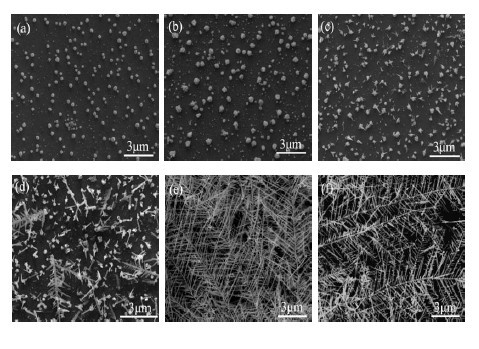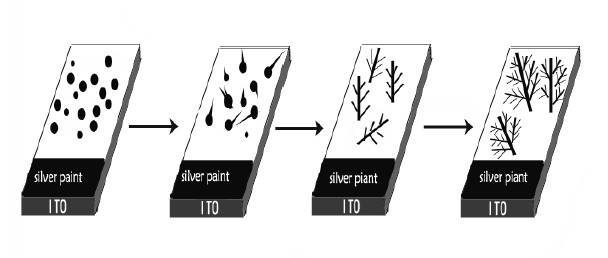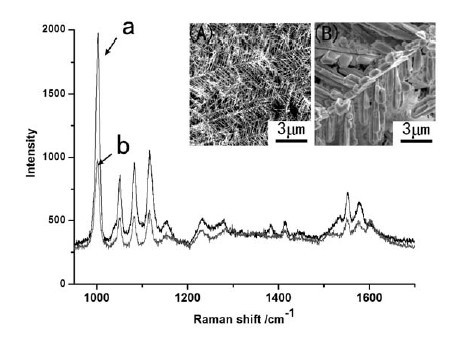Silver nanodendrite surface enhanced Raman scattering (SERS) substrate, and preparation method and application thereof
A surface-enhanced Raman and silver nanotechnology, applied in Raman scattering, nanotechnology, material excitation analysis, etc., can solve the problem of high-concentration HF solution limiting the application range, metal activity limiting the use of substrate raw materials, and limiting large-scale applications and other problems, to achieve the effect of enhancing surface Raman scattering activity, fast and convenient preparation process, and adjustable size
- Summary
- Abstract
- Description
- Claims
- Application Information
AI Technical Summary
Problems solved by technology
Method used
Image
Examples
Embodiment 1
[0030] Add 8ml AgNO to a 10ml electrolytic cell 3 (0.02 mol·L -1 ) solution as the electrolyte, a small piece of ITO is inserted into the electrolytic cell as the working electrode, the effective part immersed in the electrolyte is 1 cm×0.5 cm, and the Pt wire is used as the reference electrode and the counter electrode. Turn on the working current and adjust it to 5 mA, silver nanodendrites grow on the surface of ITO, turn off the current after 14s, rinse the ITO substrate with water, and dry to obtain the SERS active substrate.
[0031] The above-mentioned active substrate with SERS effect on the surface was used as the Raman detection substrate, 2, 2’-dithiobipyridine was used as the probe molecule, and methanol was used as the solvent to prepare it at a concentration of 1 μmol L -1 solution, use a micro-syringe to measure 50 μl and drop it on the substrate, and do Raman detection after the solvent evaporates (JY-T64000 Raman spectrometer, excitation wavelength is 632.8 nm...
Embodiment 2
[0033] Add 8ml AgNO to a 10ml electrolytic cell 3 (0.02 mol·L -1 ) solution as the electrolyte, a small piece of ITO is inserted into the electrolytic cell as the working electrode, the effective part immersed in the electrolyte is 1 cm×0.5 cm, and the Pt wire is used as the reference electrode and the counter electrode. Turn on the working current and adjust it to 5 mA, silver nanodendrites grow on the surface of ITO, turn off the current after 10s, wash the ITO substrate with water, and dry to obtain the SERS active substrate.
[0034] The active substrate with the SERS effect obtained above was used as the Raman detection substrate, and 2,2'-dithiobipyridine was used as the probe molecule, and the Raman detection was performed according to the method in Example 1, and it was clearly observed that 2, The characteristic peak of 2'-dithiodipyridine, its Raman signal intensity is close to that of Example 1.
Embodiment 3
[0036] Add 8ml AgNO to a 10ml electrolytic cell 3 (0.02 mol·L -1 ) solution as the electrolyte, a small piece of ITO is inserted into the electrolytic cell as the working electrode, the effective part immersed in the electrolyte is 1 cm×0.5 cm, and the Pt wire is used as the reference electrode and the counter electrode. Turn on the working current and adjust it to 5 mA. Silver nanodendrites grow on the surface of ITO. After 30s, turn off the current, rinse the ITO substrate with water, and dry it to obtain the SERS active substrate.
[0037] The active substrate with the SERS effect obtained above was used as the Raman detection substrate, and 2,2'-dithiobipyridine was used as the probe molecule, and the Raman detection was performed according to the method in Example 1, and it was clearly observed that 2, The characteristic peak of 2'-dithiodipyridine, its Raman signal intensity is equivalent to that of Example 1.
PUM
 Login to View More
Login to View More Abstract
Description
Claims
Application Information
 Login to View More
Login to View More - R&D
- Intellectual Property
- Life Sciences
- Materials
- Tech Scout
- Unparalleled Data Quality
- Higher Quality Content
- 60% Fewer Hallucinations
Browse by: Latest US Patents, China's latest patents, Technical Efficacy Thesaurus, Application Domain, Technology Topic, Popular Technical Reports.
© 2025 PatSnap. All rights reserved.Legal|Privacy policy|Modern Slavery Act Transparency Statement|Sitemap|About US| Contact US: help@patsnap.com



